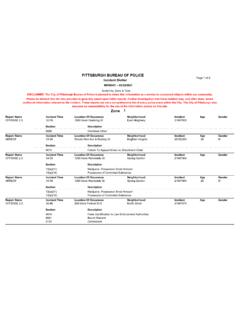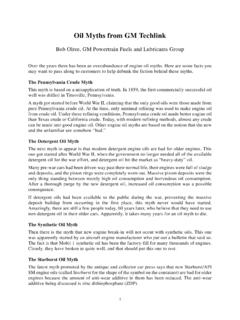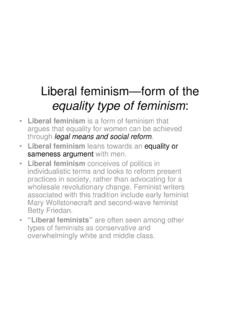Transcription of ALLEGHENY COUNTY HOARDING TASK FORCE - …
1 1 ALLEGHENY COUNTY HOARDING TASK FORCE HOARDING NON-CLINICAL EDUCATION CURRICULUM DEVELOPED BY THE EDUCATION WORKGROUP AUGUST, 2017 INTRODUCTION The ALLEGHENY COUNTY HOARDING Task FORCE is a collective group of individuals working to accomplish the mission of the Task FORCE . The Task FORCE does not have and cannot accept funding and does not engage, intervene or consult on individual HOARDING cases, concerns or situations. The mission of the ALLEGHENY COUNTY HOARDING Task FORCE is to better understand the nature and extent of HOARDING , increase education and awareness and coordinate community resources in ALLEGHENY COUNTY , so community services are better able to respond to individuals with HOARDING disorder. Combating and mitigating HOARDING in our community requires a multi-disciplinary approach and cannot be overcome by any single agency or discipline. This document has been created by members of the HOARDING Task FORCE Education Workgroup. Information in this document has been developed by its members through professional experience and research.
2 This documents is not meant to replace professional or legal advice. It is a first step to learn a bit more about HOARDING and HOARDING disorder and the complex issues that are faced by people with this disorder. Target Audience: Community segments and organizations that do not exclusively work with individuals with a HOARDING disorder, but may come across HOARDING in their line of work, such as code enforcement, municipal workers, first responders, insurance industry employees among other populations that are seeking more information about HOARDING disorder. Purpose: Examine multiple components of HOARDING , including HOARDING disorder basic definitions, stages of HOARDING , risk factors, safety and interaction. Sincerely, ALLEGHENY COUNTY HOARDING Task FORCE 2 TABLE OF CONTENTS Introduction .. 1 Background and Definitions .. 4 What is HOARDING ? .. 4 Collecting and HOARDING .. 4 Common Characteristics of an Individual with HOARDING disorder .. 4 debunking the Myths of HOARDING .
3 5 Stages of HOARDING .. 6 Stage 1 .. 6 Stage 2 .. 7 Stage 3 .. 8 Stage 4 .. 9 Stage 5 .. 10 HOARDING Disorder Risk Factors .. 11 Age .. 11 Dementia .. 11 Depression and Anxiety .. 11 Social Phobia and Isolation .. 11 Personality and Decision Making .. 12 Trauma and Stress .. 12 Clean up and Remediation .. 13 Road blocks and Barriers to Treatment .. 13 Money and Finances .. 13 Client Self-insight .. 14 Physical 14 Support .. 14 Stigma and Discrimination .. 14 Transportation and Community Access .. 14 Legal Support for People with a HOARDING Disorder .. 15 Protective Service Contact Numbers .. 15 Safety and Precautions .. 16 3 Animals and Vermin .. 16 Structural Dangers .. 17 Precautions and Personal Protective Equipment .. 18 Standard Precautions .. 18 Personal Protective Equipment (PPE) .. 18 Community and Public Health Concerns .. 20 Fire and Medical Responders .. 20 Conclusion .. 21 Works Cited and References .. 22 4 BACKGROUND AND DEFINITIONS W HAT IS HOARDING ?
4 HOARDING is the excessive acquiring and accumulation of items along with a persistent inability to discard items because of a perceived need to save. These items may have little value or utility. The thought or action of discarding an item will cause discomfort and distress. COLLECTING AND HOARDING Collecting A person who collects items of a specified type, professionally or as a hobby. A collector differs from a hoarder in that a collector displays and cherishes their items while being able to set boundaries on their acquisitions and fully understand their collections actual value. HOARDING HOARDING is the excessive acquiring and accumulation of items along with a persistent inability to discard items because of a perceived need to save. These items may have little value or utility. The thought or act of discarding an item will cause discomfort and distress. An Individual suffering from HOARDING disorder has persistent difficulty discarding or parting with possessions, regardless of their actual value.
5 COMMON CHARACTERISTICS OF AN INDIVIDUAL W ITH HOARDING DISORDER Individuals with HOARDING disorder are often stigmatized. The HOARDING Task FORCE Education Workgroup has reflected on their experiences working and supporting with individuals with HOARDING disorder and has developed the follow list of common characteristics about individuals with HOARDING disorder. Individuals with HOARDING disorder are Visual learners Highly educated Creative Passionate Have strong environmental concerns Enjoy giving to others Enjoy reading Strive for knowledge 5 debunking THE MYTHS OF HOARDING In the left-hand column below, a common stereotype about individuals with HOARDING disorder is presented and the right-hand column a more common reality is presented. Information in this section was developed based on discussion with professionals on the HOARDING Task FORCE Education Workgroup based on their experiences. HOARDING Stereotype HOARDING Reality Hoarded homes are filthy.
6 Not all hoarded homes are filthy. Many hoarded homes are organized and clean. All HOARDING homes have bugs and vermin. Many hoarded homes do not have an infestation. People who hoard are poor. HOARDING affects people of all socio-economic status and backgrounds. People who hoard are lazy. Individuals who suffer from HOARDING disorder often struggle with depression. This makes doing everyday tasks very difficult. People who hoard are agoraphobic and/or anti-social. A lot of people who hoard have a community and family who love them. People who hoard are overweight. Individuals who suffer from HOARDING disorder come in all shapes and sizes. People who hoard are uneducated. Most individuals who hoard not only have an education but often have had well-paying jobs either in the past or present. 6 STAGES OF HOARDING HOARDING disorder is chronic and progressive, meaning HOARDING is likely to increase over time. The Clutter Image Rating Scale is used to determine the extent of clutter.
7 For more information about this scale please click on the link below. The clutter image rating scale uses 9 stages, however in the descriptions below a 1 to 5 scale is used, with stage 1 being least advanced and stage 5 most advanced. The categories below outline the stages of HOARDING . Click the link below to access the Institute for Challenging Disorganization Clutter Rating Scale for more detail: STAGE 1 Stage 1 following the Clutter Image Rating Scale is the least advanced level of HOARDING . At this stage HOARDING behavior and habits become solidified. Below are common characteristics that may present in stage 1 All doors and stairways are accessible All amenities are accessible and working Functioning bathroom and clean clothes All family members and pets are healthy, clean, and well nourished Maintained finances Invites friends over 7 Not generally viewed as a hoarder Feelings of anxiety about their clutter, with minimal effects Pet behavior and sanitation is generally appropriate No excessive clutter All rooms are being used for their intended purpose STAGE 2 In stage 2, indicators of HOARDING become more identifiable.
8 Safety issues are starting to arise and impaired functioning is starting to present, including accessibility and mobility constraints. One exit to the house is blocked or one room is unusable One major appliance is not in working order because it is too difficult to access Less attention is being paid to housekeeping. ( Dishes are piling up and shelves remain dusty) Pet odors becoming noticeable. Shift in focus from life to clutter. Diminished social and family interaction Reduction in the number of guests they have over because of embarrassment Mild anxiety and depression Shifting from embarrassment to justification Visible pet fur, hair and dander Light to medium evidence of pests and/or insects Inconsistent routine housekeeping and maintenance Slight congestions of exits and hallways Clutter obstructs some living area. 8 STAGE 3 Stage 3 is the mid-point on the Clutter Image Rating Scale and signs of HOARDING are starting to become evident to outsiders.
9 Indoor items may be stored or tossed outside Minor structural damage Evidence of excessive extension cord use and phone lines when outlets get blocked off Pets may have fleas The kitchen sink may be full of dishes and standing water Stairs and walkways are generally extensively cluttered and difficult to navigate Outside storage (shed or garage) is overflowing Personal care is neglected Consuming reheated, precooked, or fast food because the kitchen is only borderline functional Decreased physical activity Family has attempted to intervene numerous times and is faced with rejection and withdrawal. Work place problems Growing financial concern Clutter obstructs functions of living area. At least one room is not being used for its intended purpose 9 STAGE 4 Stage 4 consists of advanced structural damage in several areas, including sagging floors and ceilings. Major appliances are no longer working properly or at all. The house and contents pose a significant safety risk to occupants.
10 Additionally, individuals will not have access to fresh foods and safe/workable food preparation area and utensils. Mold, bugs, and cobwebs may be present Contents are stored in uncommon places such as clothes hanging on the shower curtain rod or important documents in the oven Individuals who hoard will remain in very small area of the house, The Cockpit Bathe in the sink or not at all Struggle to get to work on time or no longer working Significantly behind on bills and other serious financial troubles Utilities may be shut off Pets may have run away or died in the house Individuals may have shut everyone out of their lives Water damaged floors Broken walls, foundations, windows/doors Rooms cannot be used for their intended purpose 10 STAGE 5 Stage 5 is the most advanced and profound stage. HOARDING is evident and the property is highly unsafe and inhabitable. Major structural damage to the house Severe mold, strong odors, bugs, rodents, and cobwebs Entire floors of the house might be blocked off Walls of items in every room Struggling to complete simple tasks like eating, sleeping, using the restroom Limited to consuming soft drinks, fast-food or expired foods Family and friends (if they are still in contact with them) are deeply concerned Serious financial problems Severe, debilitating depression Confusion Isolated to their house, unless it is to move into their car or a homeless shelter 11 HOARDING DISORDER RISK FACTORS The purpose of this section is to identify risk factors (antecedents) that may lead an individual to hoard.















